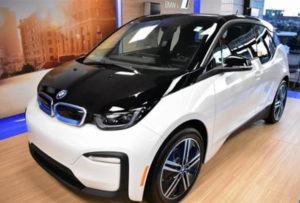
Although still representing a minuscule percentage of the automobiles on state roads, electric vehicle sales are slowly but steadily growing in Connecticut.
Whether they will continue to do so depends, in part, on the Trump administration”™s decision announced last month to roll back auto emissions standards.
The administration wants to freeze antipollution and fuel-efficiency standards that the Connecticut Department of Energy and Environmental Protection, among others, say compel auto manufacturers to make their vehicles significantly more fuel-efficient.
The proposed changes would also eliminate a waiver allowing Connecticut and other states to establish their own gas mileage standards as part of their efforts to reduce greenhouse gas pollution, producing angry disapproval in some quarters.
“This is a decision to ignore all of the warnings on air quality and on greenhouse gas emissions and say to Connecticut, and other states who are struggling to address air pollution, ”˜screw you”™,” Rob Klee, commissioner of the state”™s Department of Energy and Environmental Protection (DEEP), told NPR last month.
While Klee was not available for further comment, Paul Farrell, DEEP”™s assistant director for air quality, told the Business Journal that the commissioner”™s sentiments reflected those of himself and the agency at large.
Transportation accounts for some 41 percent of Connecticut”™s carbon emissions, Farrell said, while 67 percent of all nitrogen oxide emissions in the state come from cars, trucks, and similar gas-burning equipment like lawn mowers.
“That”™s by far the biggest source in aggregate of air pollution in Connecticut,” he said. If the proposed rollbacks take place, “We have no chance of meeting our fresh air quality standards in the time required.”
Under Connecticut”™s Global Warming Solutions Act, greenhouse gas emissions are mandated to be 10 percent below 1990 levels by 2020, and to be approaching 80 percent below 2001 levels by 2050.
Farrell said that DEEP and the state are considering litigation over the matter.
“The Trump administration is determined to roll back protections, like these auto emissions standards, that are critical to the health, safety and well-being of Connecticut residents,” Attorney General George Jepsen said.
“As a downwind state,” he continued, “Connecticut struggles to maintain our air quality, and lessening standards for passenger cars and light-duty trucks nationwide will only exacerbate the problem. My office will continue to work with our partners in other states to aggressively fight this administration”™s assault on clean air.”
In the meantime, according to the International Energy Agency, the number of electric and plug-in hybrid cars on the world”™s roads exceeded 3 million in 2017, up 54 percent over 2016. China was the largest market by a wide margin, accounting for nearly half the year”™s total with nearly 580,000 electric cars sold, up 72 percent from the previous year. The U.S. placed second, with about 280,000 cars sold in 2017 compared with 160,000 in 2016.
According to the Electric Vehicle Club of Connecticut (formerly the Westport Electric Car Club), 6,264 vehicles were sold in Connecticut last year compared with 4,636 in 2016. Board member and secretary Barry Kresch noted that the term “electric vehicle” (EV) includes both battery electric vehicles (BEV) and plug-in hybrid vehicles (PHEV).
So far this year, EVs represent 0.28 percent of all vehicles registered in the state, up from 0.20 percent for the same period last year. “EV sales have been growing by double digit percentage increases for several years now,” Kresch said, noting that Greenwich leads all Fairfield County towns by a large margin: 511 compared with second-place Stamford”™s 298.
DEEP”™s Farrell noted that the Connecticut Hydrogen and Electric Automobile Purchase Rebate (CHEAPR) offers incentives of up to $5,000 for state residents who purchase or lease a new eligible EV; there are more than 40 eligible vehicles available, he said, with the list continuing to grow as manufacturers release new models.
James Fleming, president of the Connecticut Automotive Retailers Association (CARA), said that Connecticut currently ranks eighth in EV sales and is behind only Vermont in the Northeast. The group played a key part in establishing CHEAPR, he said.
“We”™re doing well,” he said, “Manufacturers are looking to sell now, not 10 months from now, which has made a big difference in Connecticut.”
Also helping is the roughly $8.4 million Connecticut received from a $108 million federal settlement from Volkswagen, which the carmaker paid when caught violating the Clean Air Act by selling vehicles designed to circumvent emissions tests; some of that money is being used for Connecticut”™s EV policy.
Connecticut joined with 11 other states and the District of Columbia to create a “Northeast Corridor Regional Strategy for Electric Vehicle Charging Infrastructure.” Released earlier this year, it established goals for promoting EVs and installing charging stations. Not having ubiquitous charging stations has worked against more widespread adoption of EVs, Farrell said.
There are now 313 public charging stations in Connecticut, offering 678 outlets. In April, two new chargers were unveiled at the Westfield Trumbull Mall.
Fairfield County dealers said that general interest in EVs has been on the rise. “It”™s getting better,” said Tim Kraemer, general manager at BMW of Bridgeport. “The biggest issue has been the range (how far cars can go on a single charge), and BMW has addressed that” with such models as its X5 SUV and i3 and i8 sedans, he said.
Such vehicles “are not for everyone,” Kraemer said, “but in general people want to do good things, things that are good for the environment.”
Higher prices ”” the i3”™s MSRP is $53,895, while the X5 starts at $60,700 — are offset by rebates and incentives on leases, Kraemer said, noting that in addition to the state”™s CHEAPR program, a federal tax credit can reduce an EV”™s purchase price by $7,500.
Kraemer said the power that”™s obvious when driving such a vehicle also makes a difference. “It”™s such a smooth acceleration and it”™s faster than its gas counterparts,” he said.
Not all dealers are convinced, however. “It”™s been very light,” said David Beylouni, president and co-owner of the Colonial Automobile Group, whose Colonial Ford in Danbury offers that automaker”™s Focus Electric. He said the dealership sells “one or two” Focus Electrics per month.
Beylouni blamed what he called “a lack of infrastructure on the electric side” ”” the relative lack of charging stations ”” as well as the price: the standard Focus starts at $17,950 while the electric version starts at $29,120. “Usually for the consumer, it boils down to economics,” he said.
Beylouni also cited gas-powered cars”™ improved mileage. “We”™re at a peak time in engineering,” he said. “Gas-powered engines are now so fuel-efficient and very, very clean.”
He also questioned how “green” EVs ultimately are. “When the battery (in an EV) is gone, how do you get rid of it? That”™s another example of negative, ”˜brown”™ energy ”” it”™s a different kind of pollutant that you need to consider.”
Farrell downplayed such talk, but said that the fight for EVs still remains an uphill one. “Auto manufacturers are not necessarily doing this out of the goodness of their hearts,” he said. “That”™s why we”™re trying to build the necessary infrastructure. (The Trump administration action) isn”™t helping, and the manufacturers are looking several years into the future.
“If there”™s uncertainty now,” he said, “that doesn”™t help down the line.”e






















